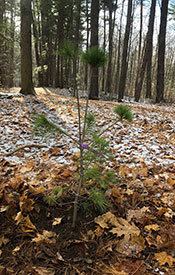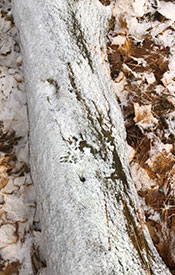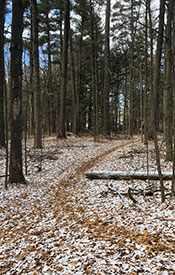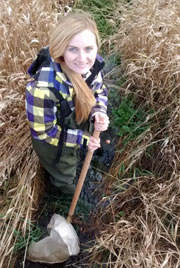First snow at Gillies Grove

Newly planted eastern white pine (Photo by NCC)
There is something magical about the first snowfall of the year. As the coordinator of conservation biology for eastern Ontario with the Nature Conservancy of Canada (NCC), I’m lucky that I get to experience all of our beautiful properties in every season. Sun, wind, rain, hail, fog — I’ve done it all, but to me, nothing beats the first snowfall.
I will admit when I woke up and looked out of my window today and saw that eastern Ontario had been transformed into a snow globe scene, I groaned. I had a very special tree to plant. But since this was the first snowfall and the ground was not yet frozen, I could get the job done.
Related content
My task for this first snowy day was planting an eastern white pine at NCC’s Gillies Grove Nature Reserve to honour the memory of NCC’s late regional vice-president, James Duncan. Gillies Grove is a breathtaking example of some of the last old-growth forest remaining in eastern Ontario — a fitting place to pay tribute to such an important conservation steward and member of the NCC family.
While I searched for the perfect spot for the tree, I was able to take in the tranquillity of the forest. Despite being in the centre of the town of Arnprior, there is a real sense of quiet in Gillies Grove. The towering eastern white pines in the forest stand even more prominently in late autumn, when their neighbouring trees have all lost their leaves. Dusted with snow, their needles swaying in the breeze, it’s hard not to think of the time when these magnificent giants dominated the landscape. Most of the old-growth forest in eastern Ontario was cut down to make way for human development.

Eastern grey squirrel footprints in snow (Photo by NCC)
Once the snow arrives, a lot of people consider the forest to be sleeping, but for me, this is when I notice that the forest is alive. Joining me on my walk were a chorus of black-capped chickadees actively calling, despite the cold. Several times I crossed paths with an eastern grey squirrel that was no doubt preparing for the harsher weather ahead.
But it’s the snow itself that reminds me that the forest is still alive in November. Worn paths through the snow showed me just how many people have had enjoyed a stroll through Gillies Grove that morning, and it was hard to find a log without some animal footprints left behind in the dusting of snow.

Path through the snow in Gillies Grove (Photo by NCC)
The spot I picked for the tree was just off the main trail, in an opening created by an older pine that had fallen. That broken tree now serves as habitat for woodpeckers, salamanders and other creatures that rely on this natural forest cycle. Planted near its towering relatives, the eastern white pine looks quite small, but given time, it will grow to make up part of the canopy of this special forest.
I don’t do as much field work in the winter, and it’s not uncommon to find me curled up with a mug of tea, writing reports about the data I collected in the summer. But these first snowy days remind me how important it is to get outside and take notice. I encourage you to take a snowy hike through your favourite natural area and see for yourself just how alive nature is during these cold months.


